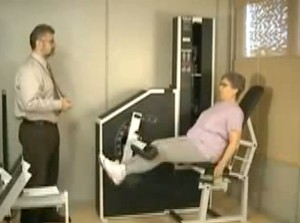Well, it only took a few minutes to Google™ up more articles than anyone could read in one lifetime about osteoarthritis and the benefits of strength training. So I scrolled down through the list and picked from what looked like the more prominent names in the study of health and exercise.
After reading them, you can probably guess what I found. They all promote strength training to help alleviate the effects of osteoarthritis.
Arthritis is the most common cause of disability in American and osteoarthritis is by far the most prevalent form of arthritis.¹
Osteoarthritis is a degenerative disease of the bone and cartilage of the joints, most commonly of the hips and knees. The cartilage starts breaking down and the joint space gradually closes. In serious cases, the space closes to a point where the joint is bone to bone, thus creating the stiffness and pain associated with osteoarthritis.
Now, for the good news! Recent studies done at Tufts University² showed that a regular exercise program, emphasizing strength training, done 2-3 times per week, benefited patients by greatly reducing the pain and stiffness associated with osteoarthritis. They found that the exercise effect in most cases was the equivalent to, or better than taking medications.²
Some of the other effects of strength training on osteoarthritis are…
- Increased bone density results in increased resistance to fractures due to falls or impacts.
- Stronger muscles, which empowers the person having them to do more activities independently, thereby elevating their overall emotional attitude towards tasks and life.
- Long-term strength training, done properly and safely, leads to increased lean muscle mass. This raises the Basal Metabolic rate, changing your body’s fat to muscle ratio. With a better body composition ratio, there is reduced stress on the joints.
- Doing strength training helps to keep the joints lubricated so they move more smoothly, with less friction and pain.
- Better balance due to stronger muscles and greater flexibility, leading to fewer falls and injuries.
So, strength training can help you slow down your biological clock.
While low impact aerobic exercise such as walking or swimming is excellent for maintaining cardiovascular health, it does very little to increase lean muscle mass. Strength training does increase lean muscle mass, and for people with osteoarthritis, more strength means a much higher quality of life!
That being said, don’t stop taking your medications and run out to the nearest gym!! Check with your healthcare practitioner and ask them whether or not it’s safe for you to exercise, and at what level.
Be sure to work with qualified trainers and do workouts that are designed to lessen the stress on your joints while still effectively building your muscles.
James Bell, Master SafeStrength® Trainer
¹ – Nicholas A. Dinubile M.D. The Physician and Sports Medicine Vol 25 – No.7 7/97
² – CDC (Center for Disease Control) – Article Growing Stronger – Strength Training for Older Adults: Why Strength Training?
Copyright© James P. Bell 2005-2014


